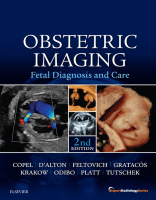Physical Address
304 North Cardinal St.
Dorchester Center, MA 02124

Introduction Twin reversed arterial perfusion (TRAP) sequence is a rare complication specific to monochorionic twin pregnancies. As a result of early vascular disruption occurring during embryogenesis, a dysmorphic acardiac twin receives circulatory support from a pump twin via aberrant placental…

Introduction Twin-twin transfusion syndrome (TTTS) is a serious condition that can complicate twin pregnancies with monochorionic diamniotic (MCDA) placentation. MCDA twin pregnancies should be monitored for TTTS with serial ultrasound (US) scans beginning in the second trimester. Early-stage TTTS can…

Introduction Twin pregnancies account for more than 3% of live births in the United States. Determination of chorionicity and amnionicity is essential in the clinical management of multiple gestations. Although dichorionic twin gestations are not associated with as many fetal…

Introduction Compared with dichorionic twin gestations, monochorionic twin gestations, whether diamniotic or monoamniotic, have an increased risk of adverse pregnancy outcomes. Ultrasound (US) plays a vital role in prenatal determination of chorionicity and in the management of monochorionic diamniotic twin…

Introduction In addition to the general risks associated with twin pregnancies and with specific risks of monochorionic gestations, monoamniotic twin gestations face the unique risk of cord entanglement and are at increased risk of fetal demise. Ultrasound (US) plays a…

Introduction In 2014, the twin birth rate in the United States rose to an all-time high of 33.9 per 1000 live births. Multiple gestations result from either the fertilization of multiple ova or the division of a single fertilized ovum…

Introduction Miller-Dieker syndrome (MDS) is a rare, contiguous gene deletion syndrome characterized by type I lissencephaly, facial dysmorphism, seizures, and severe mental retardation. Other associated defects including cardiac malformations, neural tube defects, omphalocele, gastrointestinal anomalies, genitourinary anomalies, and intrauterine growth…

Introduction Monosomy for the distal portion of the short arm of chromosome 5 causes 5p deletion syndrome, which is also known by the currently less favored term “cri du chat” syndrome, from the French description of the monotonous high-pitched “cat-like”…

Introduction First clinically described in 1961 by Hirschhorn and subsequently in 1965 by Wolf, the 4p deletion syndrome, or Wolf-Hirschhorn Syndrome (WHS), is the first example of a classic human chromosomal deletion syndrome. This rare condition, characterized by severe prenatal…

Introduction The 22q11.2 deletion syndrome is the most common human chromosomal microdeletion syndrome and one of the most common syndromes associated with prenatally detected congenital heart defects (CHDs). It has a variable phenotype, with a wide range of associated clinical…